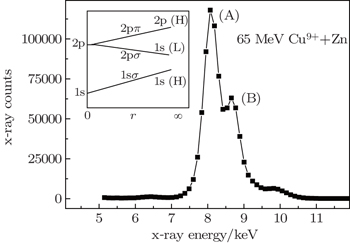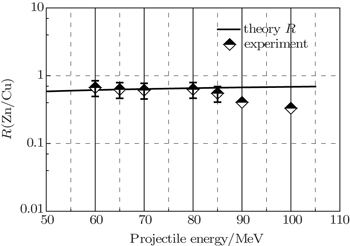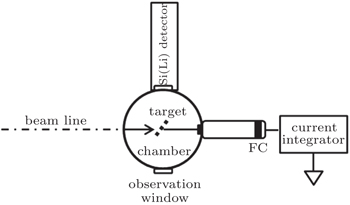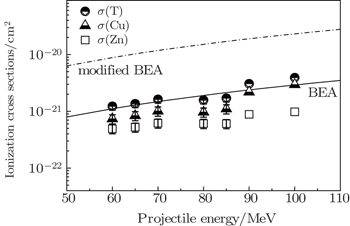† Corresponding author. E-mail:
Project supported by the Joint Funds of the National Natural Science Foundation of China (Grant No. U1332122).
We report studies on both target and projectile K-shell ionization by collisions of Cu9+ ions on the thin Zn target in the energy range of 60–100 MeV. In this work, the relative ratio for the production of the target to projectile K-vacancy is measured. The result shows that it almost remains stable over this energy range and has good consistency with the predictions by vacancy transfer via the 2pσ–1sσ rotational coupling, which gives experimental evidence for K-vacancy sharing between two partners. Furthermore, the discussion for comparisons between the experimental ionization cross sections and the possible theoretical estimations is presented. These comparisons suggest that the experimental data agree well with those predicted by the Binary–Encounter approximation (BEA) model but are not in good agreement with the modified BEA calculations. It allows us to infer that the direct ionization (and/or excitation) is of importance to initial K-vacancy production before 2pσ–1sσ transitions in the present collision condition.
The study of ion–solid collisions has great significance not only for fundamental research but also for technical application, like ion-beam modification and analysis of surfaces. In addition, the inner-shell electron excitation, ionization and transfer from one collision partner to the other, during ion–atom collisions, have been studied extensively both theoretically and experimentally for many years.[1–8] Particularly, K-shell ionization has been most widely studied for a large range of projectile number and incident energy. However, even today, a complete theory that can predict K-shell vacancy production for all collision systems in different velocities is still lacking, especially at an intermediate energy. In this range, the inner-shell processes mentioned above may all play an important part in inducing vacancies. For example, in near-symmetric systems, vacancy transfer via 2pσ–1sσ radial coupling can result in both the projectiles and target atoms K-holes production, based on the Fano–Lichten model.[9–11] Unfortunately, as for vacant 2pσ molecular orbitals (MOs) production, Morenzoni et al., Knudson et al., and Feldman et al. argued that they originate from 2pσ–2pπ electron promotion, whether or not there are vacancies in higher-Z partner L-shell, i.e., 2pπ vacant MOs, before interactions with target atoms.[9,12–16] In contrast, Winters et al. and Mizogawa et al. argued that the light-Z partner K-shell electrons can be directly removed to a level higher than 2p or continuum states, and then these vacancies evolve to 2pσ and share between two partners. Only if the higher-Z partners bear the L-shell vacancies, will the 2pσ–2pπ electron promotion predominate the 2pσ generation.[17,18] So far, it is not clear where the electron promotion picture breaks down and where the direct production processes become the dominant role when the higher-Z partners do not carry L-shell holes before entering the target. On the other hand, the detailed research on the vacancy sharing ratio between 2pσ and 1sσ as a function of incident energy is scarcely reported, since previous studies were mainly focused on searching for the origin of 2pσ production by different experimental designs. However, in order to confirm the individual inner-shell process, both the experimental sharing ratio and ionization cross sections should be investigated when no initial 2p-vacancies are brought into the collisions.
Toward this end, in the present paper, we extend the investigation to the detailed comparisons of both the sharing ratio and ionization cross sections with the theoretical predictions by 60–100 MeV Cu9+ ions incident on the thin Zn target. Specifically, we have measured the target and projectile K-shell ionization cross section ratio as a function of the incident energy. It shows very weak dependence on the incoming energies and agrees well with the prediction of K-vacancy sharing via the 2pσ–1sσ rotational coupling. Experimentally, it gives clear evidence for vacancy transfer between 2pσ–1sσ MOs. Besides, both the projectile and target ionization cross sections are measured, and physical mechanisms responsible for the initial Cu9+ ions K-vacancy production before 2pσ and 1sσ coupling are discussed. The total ionization cross sections give a good agreement with the Binary–Encounter approximation (BEA) calculations, while they deviate from the modified BEA model. Hence, in the present collision system and energy range, as supported by the experimental results, we are of the view that the initial K-holes direct production plays a predominant role in collisions.
The experimental set-up is schematically shown in Fig.
Typical x-ray spectra taken with the Si(Li) detector are shown in Fig.
 | Fig. 2. The x-ray spectra emitted in collisions Cu9+ + Zn at 65 MeV. The inset in the upper left corner is a simple molecular orbital correlation diagram for Cu+Zn system.[10,11] |
To explain production of both projectile and target K-holes, we first present a simple molecular orbital correlation diagram (the insert in Fig.
Specifically, as partners retreat, the 1sσ electrons transfer to the unoccupied 2pσ MOs via the radial coupling 2pσ–1sσ with a certain probability W of less than 1/2. Here, 1sσ and 2pσ MOs evolve from Zn 1s and Cu9+ 1s atomic orbitals, respectively. After they completely separate, part of the vacancies exist in the 1s-shell of the Zn atomic orbitals. Hence, both the projectile ions and the target atoms are in 1s-ionized state after the collisions. Moreover, obviously, the ratio of K-shell ionization cross sections for the target to the projectile ions strongly reflects the vacancy ratio R in 1sσ to 2pσ, which equals to W/(1−W). The experimental ratio σ(Zn)/σ(Cu) as a function of the incoming energy is shown in Fig.
 | Fig. 3. Ratio of the K-shell ionization cross sections between Zn and Cu9+ ions, σ(Zn/Cu), as a function of the incident energy. The solid line represents the ratio value proposed by Meyerhof.[9] |
Based on the above physical process and the procedure presented by Meyerhof, the transfer probability W between 2pσ and 1sσ MOs can be expressed as[9]


Hence, the K-vacancy sharing ratio between the target and the projectile, R, is expressed by

However, it should turn our attention to K-vacancies production in projectile Cu9+ ions since the collision systems bring no initial K- or L-shell holes into the interactions. The relative velocity between two partners in the present experiment is about 1/5 to 1/3 of the Cu9+ 1s electron velocity, therefore, one explanation is that molecular-orbital (MO) effect might reasonably be expected for the production of the 2pσ vacancies, i.e., Cu9+ K-vacancies. To be specific, the Zn 2p vacancies are first formed in an initial collision and the vacancies are transferred along 2pπ to 2pσ orbitals resulting in Cu9+ ions 1s-holes in a second violent collision. Meanwhile, another plausible interpretation to account for our experimental data is the direct ionization (and/or excitation) bringing the Cu9+ ions 1s-holes as the initial 2p vacancies are not present in target Zn for this work. The above two processes for Cu9+ ions K-vacancies production cross sections before 2pσ–1sσ sharing are described by the binding energy modified BEA model and BEA model, respectively.
In searching for a more accurate origin of the Cu9+ ions 1s-vacancies, first, the experimental ionization cross sections, σ(cm2/atom), are given, which are deduced from the relation[20,21]

The experimental projectile K-shell ionization cross sections σ(Cu), the target K-shell ionization cross sections σ(Zn), and the total ionization cross sections σ(T) versus the indent energies are shown in Fig.
Next, theoretical ionization cross sections calculated by the BEA model and the binding energy modified BEA are established. In the analysis below, Cu9+ beams and Zn atoms play a role of “target” and “projectile”, respectively, as K-vacancies produce in Cu9+ ions first. The detail of the models will be discussed in the following.
According to the BEA model, the K-shell ionization cross sections are given by[24]


Nevertheless, it is worth noticing that, in Figs.
Both the target and projectile K-shell ionization cross sections have been measured in 60–100 MeV near-symmetric collisions of Cu9+ ions with the thin target Zn. The data show that even if the projectile does not carry initial L-shell vacancies, the inner-shell ionization can occur in the projectile and the target and both ionization cross sections are of the same order of magnitude. The ratio of target to projectile K-shell ionization exhibits a very weak dependence on projectile energy and agrees well with the K-vacancy sharing predictions. Besides, the total ionization cross sections are found to be in fair agreement with the BEA model, while the modified BEA calculations do not reproduce our result. Hence, we conclude that 2pπ–2pσ rotational coupling fails to explain the initial K-holes production, while the Cu9+ ions direct ionization (and/or excitation) is the dominant process in the present work. In summary, a violent collision directly induces a K-vacancy in Cu9+ ion, which shares between two partners, subsequently, and results in both the Zn atom and Cu9+ ion being in K-ionization state, finally. However, at what Z and incident energy the direct process will play a dominant role when there is no L-shell vacancy in higher-Z partner is still not clear, so further experimental and more thorough theoretical studies on K and higher n-shell vacancy production in ion–atom collisions are required to clarify the situation.
| 1 | |
| 2 | |
| 3 | |
| 4 | |
| 5 | |
| 6 | |
| 7 | |
| 8 | |
| 9 | |
| 10 | |
| 11 | |
| 12 | |
| 13 | |
| 14 | |
| 15 | |
| 16 | |
| 17 | |
| 18 | |
| 19 | |
| 20 | |
| 21 | |
| 22 | |
| 23 | |
| 24 |




